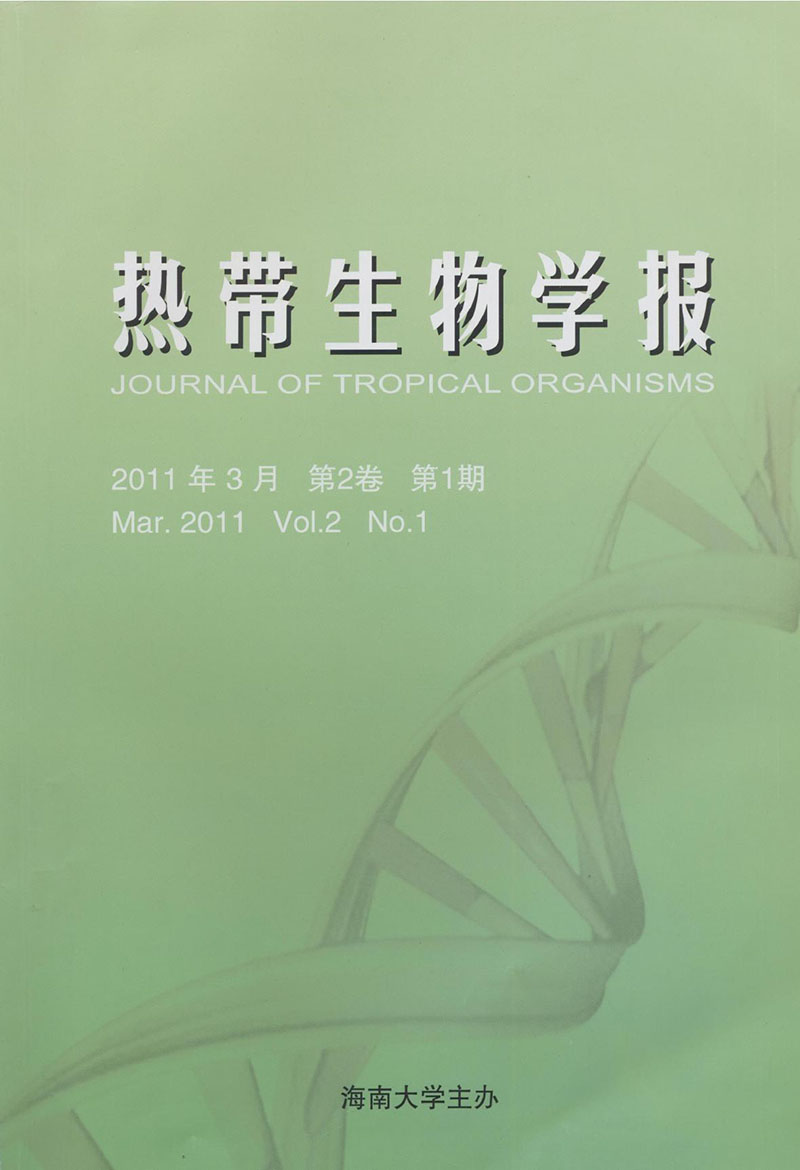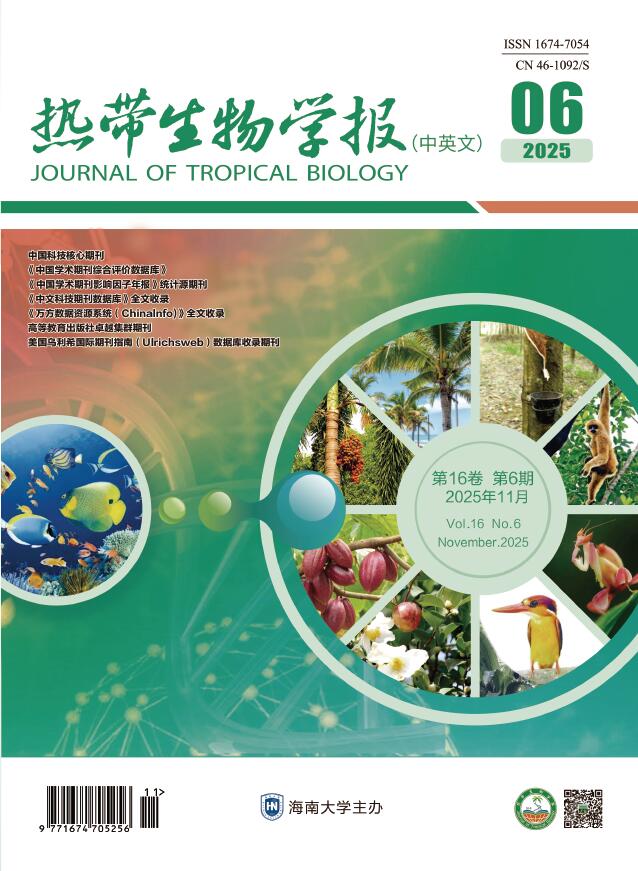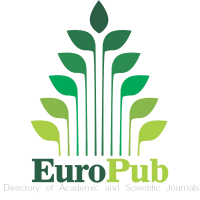2011 Vol. 2, No. 1
2011, 2(1): 1-5.
doi: 10.15886/j.cnki.rdswxb.2011.01.001
Abstract:
Myeloid differential protein-2(MD2) cDNA of Hainan Eld’s deer(Cervus eldi hainanus) was amplified by RT-PCR and the sequences were analyzed.The bioinformatics analysis results indicated that MD2 cDNA ORF contained a 486 bp encoding 161 amino acids;compared to yellow cattle,human,rabbit and mouse,the nucleotide sequence homology of MD2 were 98.55%,77.43%,78.47% and 74.74%,respectively;relative molecular weight was 19 000,pI was 8.18.The molecular structure prediction results suggested that the protein was non-transmembrane protein,which contained 16.25% α-helix,38.13% β-meander,45.63 % random coil.
Myeloid differential protein-2(MD2) cDNA of Hainan Eld’s deer(Cervus eldi hainanus) was amplified by RT-PCR and the sequences were analyzed.The bioinformatics analysis results indicated that MD2 cDNA ORF contained a 486 bp encoding 161 amino acids;compared to yellow cattle,human,rabbit and mouse,the nucleotide sequence homology of MD2 were 98.55%,77.43%,78.47% and 74.74%,respectively;relative molecular weight was 19 000,pI was 8.18.The molecular structure prediction results suggested that the protein was non-transmembrane protein,which contained 16.25% α-helix,38.13% β-meander,45.63 % random coil.
2011, 2(1): 6-13,20.
doi: 10.15886/j.cnki.rdswxb.2011.01.002
Abstract:
Based on consensus sequence of vacuolar-type Na+/H+ antiporter genes(NHX1),the primers were designed to isolate a cDNA fragment of NHX1 from Rhizophora stylosa by RT-PCR.The full length cDNA was obtained by rapid amplification of cDNA ends(RACE),and the gene was termed as RsNHX1.This gene is 2 094 bp in length and contains one open reading frame of 1 614 bp,encoding 538 amino acid residues.Accession number of GenBank is FJ627273.Bioinformatics analysis results showed that the amino acid sequence of the RsNHX1 gene is 74% and 69% similar with that of PeNHX1(ABY86892,Populus euphratica) and AtNHX1(AAM34759,Arabidopsis thaliana),respectively.There are significant differences among these sequences.
Based on consensus sequence of vacuolar-type Na+/H+ antiporter genes(NHX1),the primers were designed to isolate a cDNA fragment of NHX1 from Rhizophora stylosa by RT-PCR.The full length cDNA was obtained by rapid amplification of cDNA ends(RACE),and the gene was termed as RsNHX1.This gene is 2 094 bp in length and contains one open reading frame of 1 614 bp,encoding 538 amino acid residues.Accession number of GenBank is FJ627273.Bioinformatics analysis results showed that the amino acid sequence of the RsNHX1 gene is 74% and 69% similar with that of PeNHX1(ABY86892,Populus euphratica) and AtNHX1(AAM34759,Arabidopsis thaliana),respectively.There are significant differences among these sequences.
2011, 2(1): 14-20.
doi: 10.15886/j.cnki.rdswxb.2011.01.016
Abstract:
The different processing methods were performed to extract the crude antimicrobial peptides extraction from the mantle and gill tissues of Pincatda martensii,and the activities of crude extractions were compared.The result suggested that the activities of crude extractions were not changed when Pincatda martensii was induced by Streptococcus agalactiae with 1.0×106 cfu·mL-1 for 14 h;the antibacterial activity of crude extractions homogenated by IKAT-18 homogenate machine was higher than that by the tissue grinder and the agate mortar;the antibacterial activity against Vibrio alginolyticus was significantly improved when the extraction was heated at 100 ℃ for 10 min;and the antibacterial activity against V.alginolyticus was significantly reduced when the crude extractions of the mantle tissue from P.martensii was frozen and thawed repeatedly.
The different processing methods were performed to extract the crude antimicrobial peptides extraction from the mantle and gill tissues of Pincatda martensii,and the activities of crude extractions were compared.The result suggested that the activities of crude extractions were not changed when Pincatda martensii was induced by Streptococcus agalactiae with 1.0×106 cfu·mL-1 for 14 h;the antibacterial activity of crude extractions homogenated by IKAT-18 homogenate machine was higher than that by the tissue grinder and the agate mortar;the antibacterial activity against Vibrio alginolyticus was significantly improved when the extraction was heated at 100 ℃ for 10 min;and the antibacterial activity against V.alginolyticus was significantly reduced when the crude extractions of the mantle tissue from P.martensii was frozen and thawed repeatedly.
2011, 2(1): 21-25.
doi: 10.15886/j.cnki.rdswxb.2011.01.017
Abstract:
In our study,the acute biological toxic tests were performed to determine the semi-lethal concentration(LC50) of five common insecticides,including Formalin,CuSO4,CuSO4:FeSO4(5:2),Dipterex and KMnO4,to Babylonia areolata when the hatching time was 24 h and 48 h,respectively.The results indicated that LC50(24 h) of Formalin,CuSO4,CuSO4:FeSO4(5:2),Dipterex and KMnO4 to B.areolata was 81.45 mg·L-1,34.81 mg·L-1,18.17 mg·L-1,478.19 mg·L-1 and 89.12 mg·L-1,respectively;LC50(48 h) of the five insecticides was 64.72 mg·L-1,5.81 mg·L-1,12.68 mg·L-1,407.48 mg·L-1 and 43.38 mg·L-1,respectively;their safe concentrations were 12.21 mg·L-1,0.05 mg·L-1,1.86 mg·L-1,89.23 mg·L-1 and 3.10 mg·L-1,respectively.
In our study,the acute biological toxic tests were performed to determine the semi-lethal concentration(LC50) of five common insecticides,including Formalin,CuSO4,CuSO4:FeSO4(5:2),Dipterex and KMnO4,to Babylonia areolata when the hatching time was 24 h and 48 h,respectively.The results indicated that LC50(24 h) of Formalin,CuSO4,CuSO4:FeSO4(5:2),Dipterex and KMnO4 to B.areolata was 81.45 mg·L-1,34.81 mg·L-1,18.17 mg·L-1,478.19 mg·L-1 and 89.12 mg·L-1,respectively;LC50(48 h) of the five insecticides was 64.72 mg·L-1,5.81 mg·L-1,12.68 mg·L-1,407.48 mg·L-1 and 43.38 mg·L-1,respectively;their safe concentrations were 12.21 mg·L-1,0.05 mg·L-1,1.86 mg·L-1,89.23 mg·L-1 and 3.10 mg·L-1,respectively.
2011, 2(1): 26-29.
doi: 10.15886/j.cnki.rdswxb.2011.01.006
Abstract:
Confronting incubation method has been performed to obtain six antagonistic endophytic bacterial isolates from eighty seven bacterial isolates(YS01-YS87)of the endophytic bacterium in citrus.The results indicated that there were remarkable differences among antagonism against Sclerotinia sclerotiorum of different endophytic bacterial isolates,The inhibitory zone tests showed that the inhibitory activity of the endophytic bacterial isolate YS45 was the greatest in all the tested endophytic bacterial isolates,the inhibiter zone diameter of which was 2.7 cm and significantly bigger than that of others.By systematic bacteriology identification,the isolate was identified to be Bacilus subtilis.
Confronting incubation method has been performed to obtain six antagonistic endophytic bacterial isolates from eighty seven bacterial isolates(YS01-YS87)of the endophytic bacterium in citrus.The results indicated that there were remarkable differences among antagonism against Sclerotinia sclerotiorum of different endophytic bacterial isolates,The inhibitory zone tests showed that the inhibitory activity of the endophytic bacterial isolate YS45 was the greatest in all the tested endophytic bacterial isolates,the inhibiter zone diameter of which was 2.7 cm and significantly bigger than that of others.By systematic bacteriology identification,the isolate was identified to be Bacilus subtilis.
2011, 2(1): 30-34.
doi: 10.15886/j.cnki.rdswxb.2011.01.008
Abstract:
In order to explore the factors that affect the survival of grafted cassava,South China 205(SC205),South China 8(SC8),South China 9(SC9) and wild cassava were used as materials,and cleft methods were performed for grafting cassava.The results showed that the following factors such as the cambium ability,the formation of callus,the period of maturity and grafting time have an effect on the grafting;the temperature and humidity also play important role.
In order to explore the factors that affect the survival of grafted cassava,South China 205(SC205),South China 8(SC8),South China 9(SC9) and wild cassava were used as materials,and cleft methods were performed for grafting cassava.The results showed that the following factors such as the cambium ability,the formation of callus,the period of maturity and grafting time have an effect on the grafting;the temperature and humidity also play important role.
2011, 2(1): 35-41.
doi: 10.15886/j.cnki.rdswxb.2011.01.009
Abstract:
In order to establish the optimized ISSR-PCR experiment system for Pogostemon cablin,the single factor experiments were used to detect the suitable concentration ranges of the different influential factors,and then the orthogonal design was performed to optimize 5 factors(Mg2+,dNTPs,primer,Taq polymerase,DNA template) at 4 levels,which affect ISSR-PCR amplification system of Pogostemon cablin.The results indicated that a suitable ISSR-PCR reaction system established: 10×buffer 2.5 μL,40 ng DNA template,2.5 mmol·L-1 MgCl2,0.3 μmol·L-1 primers,1.5 U Taq polymerase,150 μmol·L-1 dNTPs were contained in 25 μL reaction solution.The optimized amplification program was that predenaturing at 94 ℃ for 5 min,then denaturing at 94 ℃ for 45 s,primer annealing at 52.7 ℃ for 45 s,extension at 72 ℃ for 90 s,for 40 cycles,at last extension at 72 ℃ for 7 min,and the products were stored at 4 ℃.
In order to establish the optimized ISSR-PCR experiment system for Pogostemon cablin,the single factor experiments were used to detect the suitable concentration ranges of the different influential factors,and then the orthogonal design was performed to optimize 5 factors(Mg2+,dNTPs,primer,Taq polymerase,DNA template) at 4 levels,which affect ISSR-PCR amplification system of Pogostemon cablin.The results indicated that a suitable ISSR-PCR reaction system established: 10×buffer 2.5 μL,40 ng DNA template,2.5 mmol·L-1 MgCl2,0.3 μmol·L-1 primers,1.5 U Taq polymerase,150 μmol·L-1 dNTPs were contained in 25 μL reaction solution.The optimized amplification program was that predenaturing at 94 ℃ for 5 min,then denaturing at 94 ℃ for 45 s,primer annealing at 52.7 ℃ for 45 s,extension at 72 ℃ for 90 s,for 40 cycles,at last extension at 72 ℃ for 7 min,and the products were stored at 4 ℃.
2011, 2(1): 42-45.
doi: 10.15886/j.cnki.rdswxb.2011.01.010
Abstract:
The effects of different concentrations of macro-element and combination of plant growth regulator on the mature-type Citrus grandis stem cultured in vitro were compared.The results showed when 3/4MS mediums,in which the 6-BA concentrations were 0.6 mg·L-1-0.8 mg·L-1 and NAA concentrations were 0.8mg·L-1-1.2 mg·L-1,were used,high proliferation rate were obtained;when the concentrations of 6-BA,NAA and GA3 were 0.3 mg·L-1,0.6 mg·L-1 and 0.3 mg·L-1,respectively,multiple shoots’ long-time subculture were feasible.
The effects of different concentrations of macro-element and combination of plant growth regulator on the mature-type Citrus grandis stem cultured in vitro were compared.The results showed when 3/4MS mediums,in which the 6-BA concentrations were 0.6 mg·L-1-0.8 mg·L-1 and NAA concentrations were 0.8mg·L-1-1.2 mg·L-1,were used,high proliferation rate were obtained;when the concentrations of 6-BA,NAA and GA3 were 0.3 mg·L-1,0.6 mg·L-1 and 0.3 mg·L-1,respectively,multiple shoots’ long-time subculture were feasible.
2011, 2(1): 46-48.
doi: 10.15886/j.cnki.rdswxb.2011.01.012
Abstract:
The field experiment and instrument analytical method were performed to study the effects of plant nutrients on the quality of juicy peach.The results showed that the quality of plant dealt with plant nutrition agent was higher than that of control,soluble solids,sugar and vitamin C was increased by 7%,10% and 4%,respectively;beneficial mineral elements like Zinc and Selenium were also increased by 11.33% and 28%,respectively;the content of harmful elements like Lead,Mercury and Cadmium were reduced by 5.06%,1.90% and 31%,respectively;the economic benefits was above 21 900 Yuan each hectare.
The field experiment and instrument analytical method were performed to study the effects of plant nutrients on the quality of juicy peach.The results showed that the quality of plant dealt with plant nutrition agent was higher than that of control,soluble solids,sugar and vitamin C was increased by 7%,10% and 4%,respectively;beneficial mineral elements like Zinc and Selenium were also increased by 11.33% and 28%,respectively;the content of harmful elements like Lead,Mercury and Cadmium were reduced by 5.06%,1.90% and 31%,respectively;the economic benefits was above 21 900 Yuan each hectare.
2011, 2(1): 49-52.
doi: 10.15886/j.cnki.rdswxb.2011.01.013
Abstract:
In order to comprehend floral organs and pollen biological characteristics of Okrong,the biological characteristics of their flowers,gender ratio and pollen morphology were observed,and the pollen fertility was tested.The results showed that:(1) The flowers’ types mainly were male and hermaphrodite flowers,they were small but great amount;(2) The proportion of hermaphrodite flowers was low,only 17.99%,but the inflorescence ratio at the south direction reached 47.83% in the early flowering season;(3) Their anthers were full,each anther containing 408 pollens;(4) The pollen viability of staining was lower,only 14.02%.According to the pollen morphology and size,Okrong flowers can be divided four kinds,which are large oblong oval pollen,medium oval pollen,small nearly round pollen and small irregular shaped pollen.
In order to comprehend floral organs and pollen biological characteristics of Okrong,the biological characteristics of their flowers,gender ratio and pollen morphology were observed,and the pollen fertility was tested.The results showed that:(1) The flowers’ types mainly were male and hermaphrodite flowers,they were small but great amount;(2) The proportion of hermaphrodite flowers was low,only 17.99%,but the inflorescence ratio at the south direction reached 47.83% in the early flowering season;(3) Their anthers were full,each anther containing 408 pollens;(4) The pollen viability of staining was lower,only 14.02%.According to the pollen morphology and size,Okrong flowers can be divided four kinds,which are large oblong oval pollen,medium oval pollen,small nearly round pollen and small irregular shaped pollen.
2011, 2(1): 53-58.
doi: 10.15886/j.cnki.rdswxb.2011.01.014
Abstract:
The suckers were used as explants to perform the rapid propagation of Musella lasiocarpa.The ideal medium prescription for some key procedures,such as the establishment of sterile materials,the proliferation of clustered buds and the rooting,were developed.According to the routine methods of plant tissue culture,the experiments were operated and SAS software was used to analysis the data.The results showed that after the suckers were longitudinally cut and cultured on the medium(MS+2.5 mg·L-1 6-BA + 30 g·L-1 sugar) for 20 days,the young adventitious buds continuously appeared;the best proliferation effects could be obtained by transplanting the young buds onto the medium(MS+2.0 mg·L-1 6-BA + 30 g·L-1 sugar +10% CW) for multiplication culture,on which the young shoots with deep green color grow normally,and with a proliferation coefficient of 5.47;when the concentration of 6-BA was higher than 2.5 mg·L-1,the young shoots showed a dehydrated-like growth phase,and the malformed and vitrified shoots increased;the optimum rooting effects could be obtained by transplanting the young shoot onto the medium(1/2MS+1.5 mg·L-1 NAA +2.5 mg·L-1 active carbon),on which the average root number of single plant was 3.07,the average root length was 2.43 cm,and the average rooting percentage was 96.7%.Additionally,when the vessel plantlets of Musella lasiocarpa were transplanted in the mixed substrate(river sand∶surface soil = 1∶1),the survival percentage of the young plantlets amounted to 93.7% and it grew very well.
The suckers were used as explants to perform the rapid propagation of Musella lasiocarpa.The ideal medium prescription for some key procedures,such as the establishment of sterile materials,the proliferation of clustered buds and the rooting,were developed.According to the routine methods of plant tissue culture,the experiments were operated and SAS software was used to analysis the data.The results showed that after the suckers were longitudinally cut and cultured on the medium(MS+2.5 mg·L-1 6-BA + 30 g·L-1 sugar) for 20 days,the young adventitious buds continuously appeared;the best proliferation effects could be obtained by transplanting the young buds onto the medium(MS+2.0 mg·L-1 6-BA + 30 g·L-1 sugar +10% CW) for multiplication culture,on which the young shoots with deep green color grow normally,and with a proliferation coefficient of 5.47;when the concentration of 6-BA was higher than 2.5 mg·L-1,the young shoots showed a dehydrated-like growth phase,and the malformed and vitrified shoots increased;the optimum rooting effects could be obtained by transplanting the young shoot onto the medium(1/2MS+1.5 mg·L-1 NAA +2.5 mg·L-1 active carbon),on which the average root number of single plant was 3.07,the average root length was 2.43 cm,and the average rooting percentage was 96.7%.Additionally,when the vessel plantlets of Musella lasiocarpa were transplanted in the mixed substrate(river sand∶surface soil = 1∶1),the survival percentage of the young plantlets amounted to 93.7% and it grew very well.
2011, 2(1): 59-62.
doi: 10.15886/j.cnki.rdswxb.2011.01.018
Abstract:
Different concentration avermectin and cupric sulfate solution were used to perform the assays on inhibiting fish leeches in grouper in vitro.The results indicated that fish leeches were stupefied when marinated in freshwater for 23.0±2.8 min;died in Avermectin liquid(concentration being higher than 0.002 mL·L-1) for 2h;stupefied in Abamectin liquid(concentration being 0.000 2 mL·L-1),without death;died in cupric sulfate liquid(concentration being higher than 1 mg·L-1) for 2h,but low concentration would only decrease the vigor of fish leeches.
Different concentration avermectin and cupric sulfate solution were used to perform the assays on inhibiting fish leeches in grouper in vitro.The results indicated that fish leeches were stupefied when marinated in freshwater for 23.0±2.8 min;died in Avermectin liquid(concentration being higher than 0.002 mL·L-1) for 2h;stupefied in Abamectin liquid(concentration being 0.000 2 mL·L-1),without death;died in cupric sulfate liquid(concentration being higher than 1 mg·L-1) for 2h,but low concentration would only decrease the vigor of fish leeches.
2011, 2(1): 63-66.
doi: 10.15886/j.cnki.rdswxb.2011.01.019
Abstract:
In the paper,fertilization rate,larval settlement rate,larval survival rate,survival rate of juvenile abalone,and growth rate of juvenile abalone were used as reference standards to evaluate the crossing performance of 4 different geographical groups of Haliotis diversicolor Reeve(XS is Xisha group,TW is Taiwan group,HN is Hainan group and YN is Vietnam group,respectively).The results showed that the highest fertilization rate(98.15±7.4)% was observed in TW♀×YN♂group;the highest larval settlement rate(80.41%) occurred in XS♀×YN♂group;however,the XS♀×TW♂group displayed the highest larval survival rate(73.76%),survival rate of juvenile abalone(81.2%),and growth rate of juvenile abalone(140.7μm·d).
In the paper,fertilization rate,larval settlement rate,larval survival rate,survival rate of juvenile abalone,and growth rate of juvenile abalone were used as reference standards to evaluate the crossing performance of 4 different geographical groups of Haliotis diversicolor Reeve(XS is Xisha group,TW is Taiwan group,HN is Hainan group and YN is Vietnam group,respectively).The results showed that the highest fertilization rate(98.15±7.4)% was observed in TW♀×YN♂group;the highest larval settlement rate(80.41%) occurred in XS♀×YN♂group;however,the XS♀×TW♂group displayed the highest larval survival rate(73.76%),survival rate of juvenile abalone(81.2%),and growth rate of juvenile abalone(140.7μm·d).
2011, 2(1): 67-71.
doi: 10.15886/j.cnki.rdswxb.2011.01.004
Abstract:
Based on the interview information from eight county town(35 villages,125 households) in Guangxi,multiple logistic choice model was used to analysis the farmers’ requirment for cultivate technologies of banana and and its influencing factors.The results revealed that besides the farmers’s own characteristics,the farmers’ requirments for cultivate technologies of Banana were influenced by external factors,such as technical guidance,risk factors and organization factors.The urgently required technology type of banana peasants were the prevention and control technologies of disease,high quality management technologies,fertilization technologies,soil improvment technologies,new species,"three avoidance" technology,irrigation technologies and harvest and preservation technologies.
Based on the interview information from eight county town(35 villages,125 households) in Guangxi,multiple logistic choice model was used to analysis the farmers’ requirment for cultivate technologies of banana and and its influencing factors.The results revealed that besides the farmers’s own characteristics,the farmers’ requirments for cultivate technologies of Banana were influenced by external factors,such as technical guidance,risk factors and organization factors.The urgently required technology type of banana peasants were the prevention and control technologies of disease,high quality management technologies,fertilization technologies,soil improvment technologies,new species,"three avoidance" technology,irrigation technologies and harvest and preservation technologies.
2011, 2(1): 72-77.
doi: 10.15886/j.cnki.rdswxb.2011.01.015
Abstract:
Based on the survey of rubber industry development in three major rubber planting provinces in China,Hainan,Yunnan and Guangdong,the effects of science and technology on promoting rubber tree cultivation and rubber plantation management were elucidated.Some problems in rubber tree cultivation and rubber plantation management were analyzed.Firstly,the administration and care during young rubber trees growth is not enough;secondly,research and utilization of rubber tree stock resources is not adequate;thirdly,the key techniques such as cold tolerance,drought resistance and wind resistance in rubber tree growth remain unsolved;fourthly,the soil fertility of rubber plantations is very low,and declines constantly.Moreover,the low renovation rate in low yield rubber plantation,improper composition of different age rubber trees,and weak study and application evaluation in social-economic-natural complex ecosystem of rubber forests existing in present rubber industry were also discussed.The suggestions were proposed as follows: improving overall production level of young rubber trees;accelerating the breeding of excellent rootstocks for rubber trees and developing cold tolerance,drought resistance,and wind resistance new rubber tree varieties;improving the rubber tree cultivation techniques with reduced weather damage such as wind prevention,cold tolerance and drought resistance;timely summarizing a set of high yield cultivation techniques in rubber trees;supplying enough fertilizers in rubber plantations and strengthening light fertilizer technology development;setting up and improving the periodical update rule of low yield rubber plantations;enhancing the research on rubber forest ecosystem’s function and application evaluation;Performing the technical regulations from Ministries of Agriculture effectively,which aimed at promoting the overall level of natural rubber industry in China.
Based on the survey of rubber industry development in three major rubber planting provinces in China,Hainan,Yunnan and Guangdong,the effects of science and technology on promoting rubber tree cultivation and rubber plantation management were elucidated.Some problems in rubber tree cultivation and rubber plantation management were analyzed.Firstly,the administration and care during young rubber trees growth is not enough;secondly,research and utilization of rubber tree stock resources is not adequate;thirdly,the key techniques such as cold tolerance,drought resistance and wind resistance in rubber tree growth remain unsolved;fourthly,the soil fertility of rubber plantations is very low,and declines constantly.Moreover,the low renovation rate in low yield rubber plantation,improper composition of different age rubber trees,and weak study and application evaluation in social-economic-natural complex ecosystem of rubber forests existing in present rubber industry were also discussed.The suggestions were proposed as follows: improving overall production level of young rubber trees;accelerating the breeding of excellent rootstocks for rubber trees and developing cold tolerance,drought resistance,and wind resistance new rubber tree varieties;improving the rubber tree cultivation techniques with reduced weather damage such as wind prevention,cold tolerance and drought resistance;timely summarizing a set of high yield cultivation techniques in rubber trees;supplying enough fertilizers in rubber plantations and strengthening light fertilizer technology development;setting up and improving the periodical update rule of low yield rubber plantations;enhancing the research on rubber forest ecosystem’s function and application evaluation;Performing the technical regulations from Ministries of Agriculture effectively,which aimed at promoting the overall level of natural rubber industry in China.
2011, 2(1): 78-82.
doi: 10.15886/j.cnki.rdswxb.2011.01.011
Abstract:
Field survey,specimen collection,taxonomic study and literature retrieval were combined to investigate the plants resources of Blumea DC.in China.The results indicated that there are 32 species of Blumea DC.in China,in which 3 provincial new records is B.linearis in Taiwan,B.emeiensis in Sichuan and B.aromatica in Hainan,respectively;the reserves of B.balsamifera(Linnaeus),B.riparia,B.megacephala(Randeria),and B.mollis are comparatively large;some species of this genus are endangered,such as B.veronicifolia and B.linearis;the reserves of others are comparatively small.
Field survey,specimen collection,taxonomic study and literature retrieval were combined to investigate the plants resources of Blumea DC.in China.The results indicated that there are 32 species of Blumea DC.in China,in which 3 provincial new records is B.linearis in Taiwan,B.emeiensis in Sichuan and B.aromatica in Hainan,respectively;the reserves of B.balsamifera(Linnaeus),B.riparia,B.megacephala(Randeria),and B.mollis are comparatively large;some species of this genus are endangered,such as B.veronicifolia and B.linearis;the reserves of others are comparatively small.
2011, 2(1): 83-88.
doi: 10.15886/j.cnki.rdswxb.2011.01.007
Abstract:
In the paper,the research progresses on the transcriptional factors which mediate the transcription activation of defense-related gene expression were reviewed.And the potential application of these factors in the improvement of plant disease resistance was also discussed.
In the paper,the research progresses on the transcriptional factors which mediate the transcription activation of defense-related gene expression were reviewed.And the potential application of these factors in the improvement of plant disease resistance was also discussed.
2011, 2(1): 89-96.
doi: 10.15886/j.cnki.rdswxb.2011.01.003
Abstract:
In the paper,the morphological and physiological characteristics,molecular mechanisms of plant under the enhancing UV-B radiations were reviewed,and the problems and research directions were discussed.
In the paper,the morphological and physiological characteristics,molecular mechanisms of plant under the enhancing UV-B radiations were reviewed,and the problems and research directions were discussed.



 Abstract
Abstract PDF 936KB
PDF 936KB



 Email alert
Email alert RSS
RSS